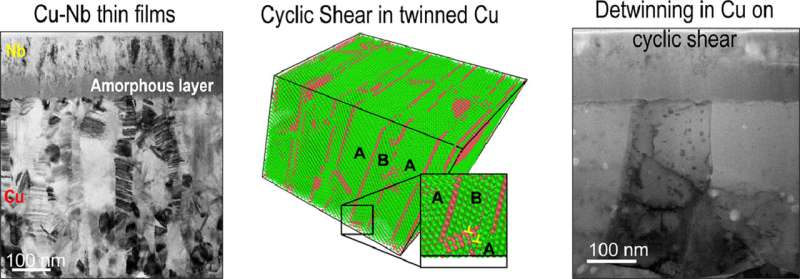This article has been reviewed according to Science X's editorial process and policies. Editors have highlighted the following attributes while ensuring the content's credibility:
fact-checked
peer-reviewed publication
trusted source
proofread
Technique offers new insight into how materials respond to stresses

Researchers have demonstrated techniques that provide unprecedented detail into how materials behave when exposed to a range of stresses, including shear stress. The work can be used to inform the development of everything from new electronic devices to high-performance textiles.
"Whether you're developing electronic devices or textile applications, it's important to understand how the materials you are using will respond to various stresses," says Bharat Gwalani, corresponding author of two papers on the work and an assistant professor of materials science and engineering at North Carolina State University. "In short, you need to know how the material will behave when it is in use.
"We've demonstrated an in situ technique that lets us see how materials respond—at the nano-scale—when it is scratched, indented or experiences shear stress," Gwalani says.
Shear stress refers to stress that is applied in a direction parallel to the surface of a material, such as when one object is dragged across the surface of another object.
"We are also able to monitor changes in material structure and mechanical properties during high-strain, cyclical shear stress, which means the shear stress is being applied repeatedly," Gwalanai says. "We commonly see cyclical shear stress when surfaces rub against each other. And for all of these modes of stresses, we're getting site-specific assessments—meaning that we can see what is happening in the areas immediately adjacent to where the stress is being applied in near real-time."
Improving our understanding of a material's mechanical characteristics under stress is important because it tells designers precisely how the material will behave when exposed to those stresses. In simple terms, measuring "stress-strain" curves tell us how much a material stretches, whether the material stiffens or becomes softer, and so on.
"Because these techniques are done in situ—meaning they can be performed without removing samples from the bulk material; and because we can see what is happening in great detail; and because all of this is happening in near real-time; we can also see how stresses affect the microstructure of the materials," Gwalani says. "For example, we can identify 'preferred slip planes,' or areas where the atoms in the material slide against each other when the material is deformed by stress."
"There are two significant advances here," Gwalani says. "First, this is the first time anyone has demonstrated the ability to collect this level of detail into mechanical responses to shear stress. Second, we are now able to see exactly how the microstructure of materials is responding to these forms of stress."
Previously, researchers could see what a material's microstructure looked like before and after these types of stress were applied. The new work means researchers are now able to see what is happening to the microstructure of these materials throughout the process of deformation.
"There are obvious applications for this work in the fields of aerospace, automobile and ceramics engineering," Gwalani says. "We think there is also tremendous potential for these techniques to advance work in energy storage, textiles, semiconductors and geochemistry. We'd love to hear from anyone in those fields who is interested in collaborating."
The researchers are currently working to advance the fundamental capability of these testing techniques so that they can be used to collect similar information at extremely high or low temperatures.
A journal article on the research involving indentation and cyclical shear stress, "Modes of Strain Accommodation in Cu-Nb Multilayered Thin Film on Indentation and Cyclic Shear," is published in the journal Surfaces and Interfaces. That paper was co-authored by Mayur Pole, Zexi Lu, Tanvi Anil Ajantiwalay, Matthew Olszta, Shalini Tripathi, Anqi Yu, Hardeep Mehta, Tianhao Wang, Xiaolong Ma and Arun Devaraj, all of the Pacific Northwest National Laboratory (PNNL).
A journal article focused solely on shear stress, "Shear Deformation of Pure-Cu and Cu/Nb Nano-laminates Using Micromechanical Testing," is published in Scripta Materialia. That paper was co-authored by Tanvi Ajantiwalay, Xiaolong Ma, Anqi Yu, Mayur Pole, Joshua Silverstein and Arun Devaraj of PNNL; and by Suveen Mathaudhu of the Colorado School of Mines.
More information: Tanvi Ajantiwalay et al, Shear deformation of pure-Cu and Cu/Nb nano-laminates using micromechanical testing, Scripta Materialia (2023). DOI: 10.1016/j.scriptamat.2023.115403
Mayur Pole et al, Modes of strain accommodation in Cu-Nb multilayered thin film on indentation and cyclic shear, Surfaces and Interfaces (2023). DOI: 10.1016/j.surfin.2023.102712















